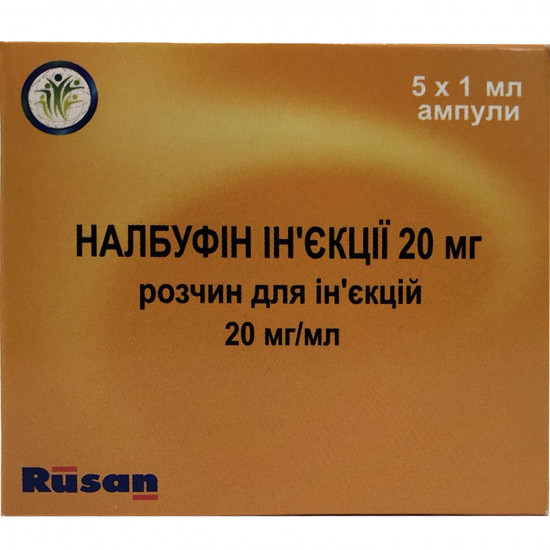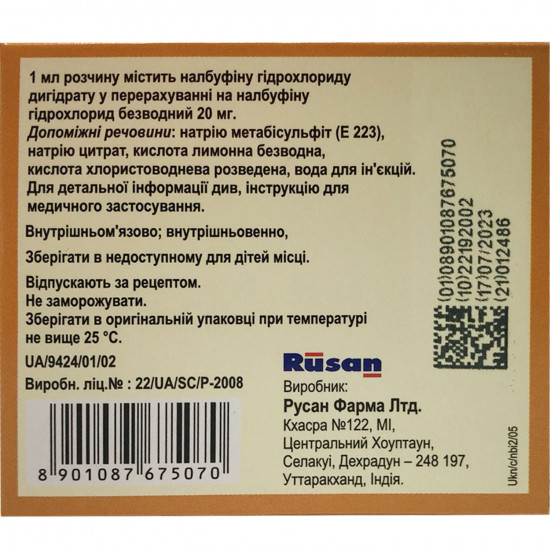



- Stock: In Stock
- Model: 184274
0% Customers recommend this product
-
5 Awesome0%
-
4 Great0%
-
3 Average0%
-
2 Bad0%
-
1 Poor0%
Reviews Over Nalbufin solution for infection. 20mg/ml amp. 1 ml No. 5
- (0)
Total Reviews (0)
click here write review to add review for this product.
Report this review.
Description
Pharmacological properties
Pharmacodynamics. nalbufin injections — opioid analgetic of group of agonists antagonists of opioid receptors (is agonist ҡ - receptors and the antagonist of µ-receptors). breaks interneural transfer of painful impulses at the central nervous system different levels, influencing the highest departments of a brain. brakes conditioned reflexes, has sedative effect, causes a dysphoria, a miosis, excites the emetic center. to a lesser extent, than morphine, Promedolum or fentanyl breaks work of a respiratory center and affects motility of a GIT. does not influence a hemodynamics. risk of development of accustoming and opioid dependence at controlled use is much lower, than for opioid antagonists. at in in introduction the effect develops in a few minutes, at in oil — in 10–15 min. the maximum effect — in 30–60 min., duration of action of 3-6 h
Pharmacokinetics. Nalbufin of an injection has the fast anesthetizing effect. Time of achievement of the C max medicament in blood at introduction in oil — 0.5-1 h. It is metabolized in a liver. It is removed in the form of metabolites with bile, in insignificant quantity — with urine. Gets through a placental barrier, during childbirth can cause respiratory depression in the newborn. It is excreted in breast milk. T ½ — 2.5-3 h
Indication
Pain syndrome of strong and average intensity; as an additional tool when carrying out anesthesia, for decrease in pain in before - and the postoperative period, anesthesia during childbirth.
Use Drug nalbufin injections appointin/in and in oil.
Dosing has to correspond to intensity of pain, a physical condition of the patient and consider interaction with other medicines applied at the same time. The dose of medicament and frequency of introduction need to be calculated carefully in order to avoid development of medicament addiction.
For anesthesia the usual recommended dose makes 0.15-0.3 mg/kg, if necessary introduction can be repeated each 4–6 h
At patients with opiate addiction symptoms of cancellation (abstinence syndrome) at use of a nalbufin of a hydrochloride can develop. In that case it is necessary to appoint morphine in/in slowly with gradual increase in a dose to disappearance of a pain syndrome.
If before purpose of a nalbufin of a hydrochloride the patient received morphine, Meperidinum, codeine or other opioid analgetic with a similar duration of activity, it is necessary to appoint at first a nalbufin a hydrochloride in a dose of 25% from necessary for the patient and to watch possible developing of a withdrawal (spastic abdominal pain, nausea, vomiting, dacryagogue, a rhinorrhea, uneasiness, excitability, a hyperthermia or a piloerektion). If the specified symptoms do not arise, the dose of a nalbufin of a hydrochloride needs to be raised gradually through the recommended periods to achievement of necessary level of anesthesia.
Maximum single dose for adults — 0.3 mg/kg, the maximum daily dose — 2.4 mg/kg. Duration of use of a nalbufin of a hydrochloride depends on a condition of the patient and has to be whenever possible the shortest in order to avoid mental or physical dependence.
In a myocardial infarction often happen enough 20 mg of medicine which are entered slowly into a vein, however increase in a dose up to 30 mg can be required. In the absence of accurate positive dynamics of a pain syndrome — 20 mg repeatedly in 30 min.
are necessary forAt use of a nalbufin of a hydrochloride as supportive application for anesthesia higher doses, than for anesthesia. For premedication — 100–200 mkg/kg.
When carrying out in/in an anesthesia: for input in an anesthesia — 0.3-1 mg/kg in/in within 10–15 min., for maintenance of an anesthesia — 250–500 mkg/kg in slowly each 30 min.
At anesthesia during childbirth medicament should be used in a dose of 20 mg in oil.
byWith care appoint medicament to patients of advanced age, in the general exhaustion, insufficient function of breath. In that case it is necessary to begin use with minimum effective doses in connection with more frequent emergence of side reactions.
Contraindication
Hypersensitivity to a nalbufin to a hydrochloride or to any of medicament components. medicine should not be applied in respiratory depression or the significant oppression of central nervous system, the increased intracranial pressure, a head injury, acute alcoholic intoxication, alcoholic psychosis. epileptic syndrome; acute surgical diseases of abdominal organs (before establishment of the diagnosis); surgeries on a gepatobiliarny system (the spasm of a sphincter of an odda is possible); medicinal dependence on morfinopodobny medicaments (morphine, Promedolum, fentanyl) — perhaps development of a withdrawal; diarrhea against the background of the psevdomembrazny colitis caused by cephalosporins, linkozamina, penicillin; toxic dyspepsia.
With care: advanced age, a cachexia, a liver and renal failure, respiratory insufficiency (including in chronic obstructive diseases of lungs, uraemia), premature births and probable immaturity of a fruit; cholelithiasis, heavy inflammatory bowel diseases, bronchial asthma, arrhythmia, AG, hypothyroidism, prostate hyperplasia, urethra stenosis; tendency to a suicide, emotional lability; the weakened patients. It is not recommended to use medicament without performing the corresponding diagnostics at a surgical belly syndrome as the nalbufina a hydrochloride can mask its manifestations.
Side effectsAt use of medicine the emergence of side reactions is possible
.
from nervous system: dizziness, the general weakness, a headache, a sedation, a diplopia, nervousness, a depression, excitement, tearfulness, euphoria, hostility, drowsiness, nightmares, hallucinations, a ring in ears, confusion of consciousness, a dysphoria, paresthesias, feeling of unreality, disturbance of the speech, change of mood; spasms, muscle tension, tremor, involuntary muscular contractions.
from a cardiovascular system: increase or decrease in the ABP, bradycardia, tachycardia.
from a digestive tract: dryness in a mouth, gripes, a constipation, dyspepsia, bitter smack, anorexia; symptoms of irritation of a GIT; a spasm of biliary tract, in inflammatory bowel diseases — paralytic intestinal impassability and toxic megacolon (constipation, a meteorism, nausea, a gastralgia, vomiting).
from a respiratory system: respiratory depression, reduction of minute volume of breath, dispnoe, asthmatic attacks.
from skin: the increased humidity of skin, an itching, urticaria, feeling of heat; ikterichnost of scleras and yellowness of skin; changes in the injection site, including morbidity.
Allergic reactions: shock, a respiratory distress syndrome, a Quincke's edema, a face edema, sneezing, a bronchospasm, a fluid lungs, skin rashes, the increased sweating.
Others: inflows, illegibility of sight; reduction of a diuresis, frequent desires to urination, a spasm of urinary tract; hepatotoxicity (dark urine, white kcal); medicinal dependence, withdrawal (spastic abdominal pain, nausea, vomiting, rhinorrhea, dacryagogue, weakness, feeling of alarm, fervescence).
Special instructions
With care needs to use medicament at emotionally unstable patients. with medicament addiction medicine can cause a bad attack of abstinency in patients. at co-administration with other derivatives of morphine the physical and mental dependence in case of prolonged use is possible. the sudden termination of introduction of a nalbufin of a hydrochloride after prolonged use can cause a withdrawal. it is not recommended to appoint this medicine in out-patient conditions because of risk of emergence of day drowsiness.
Nalbufin of an injection of 10 mg, solution for injections of 10 mg/ml, contains sodium in number of 2.84 mg/ml in each ampoule; Nalbufin of an injection of 20 mg, solution for injections of 20 mg/ml — 2.447 mg/ml of sodium in each ampoule. It should be considered when assigning to the patients who are on a rigid diet with the low content of sodium.
Nalbufin a hydrochloride has moderate ability to cause respiratory depression therefore its use can provoke development of respiratory insufficiency.
Because medicament is metabolized in a liver and is removed by kidneys, it is necessary to weigh carefully need of purpose of a nalbufin of a hydrochloride to patients with a liver and/or renal failure, and in case of need — to reduce doses and to carefully control a condition of the patient.
At use of a nalbufin of a hydrochloride by the patient at which surgery concerning surgical pathology of a gepatobiliarny system is planned should mean high risk of development of a spasm of a sphincter of Oddi.
morfinozavisimy persons or patients who completed a therapy course morphine can have a withdrawal because of antagonistic properties of a nalbufin of a hydrochloride. Drug can influence enzymatic laboratory tests for definition of medicament addiction.
does not recommend to applymedicine without performing the corresponding diagnostics at a surgical belly syndrome as the nalbufina a hydrochloride can mask its manifestations.
Use during pregnancy or feeding by a breast. Due to the lack of researches it is impossible to appoint medicament during pregnancy and feeding a breast.
Drug is used only during childbirth for anesthesia. After that it is necessary to carry out continuous monitoring of the following indicators at newborns: respiratory depression, apnoea, bradycardia, arrhythmia. These effects can be prevented by means of use of Naloxonum of the pregnant woman during childbirth.
Children. To children medicament is not used.
Ability to influence speed of response at control of vehicles or other mechanisms. During treatment of a nalbufin a hydrochloride it is necessary to abstain from control of vehicles and work with other mechanisms.
Interaction
Under fixed observation and in the reduced doses should use medicament against the background of effect of anesthetics, somnolent drugs, anxiolytics, antidepressants and neuroleptics for prevention of excessive oppression of central nervous system and oppression of activity of a respiratory center. alcohol also strengthens the oppressing action of a nalbufin of a hydrochloride on central nervous system. it should not be applied together with other narcotic analgetics because of danger of weakening of analgeziruyushchy action and a possibility of provoking of a withdrawal at patients with dependence on opioids.
Simultaneous use of a nalbufin of a hydrochloride with derivatives of a fenotiazin and medicaments of penicillin can strengthen nausea and vomiting.
Medicines with anticholinergic activity, antidiarrheal drugs, including loperamide, increase risk of developing a constipation to intestinal impassability, an ischuria and oppression of central nervous system. Nalbufina a hydrochloride strengthens hypotensive effect of the medicines lowering the arterial blood pressure including ganglioblokator, diuretics. Reduces efficiency of Metoclopramidum. With care it is necessary to apply along with MAO inhibitors because of possible overexcitation or braking with development hyper - or hypotensive crises (in the beginning for assessment of effect of interaction the dose should be reduced up to ¼ from recommended).
Incompatibility. It is not necessary to mix in one syringe with other injection solutions.
hydrochloride is compatible Nalbufin'sfrom 0.9% solution of sodium of chloride, 5% Hartman's solution.
Overdose
At overdose the respiratory depression, periodic breathing of a cheyn — Stokes arise; drowsiness, a dysphoria, change of consciousness up to a coma; pallor of skin, hypothermia, miosis; decrease hell, cardiovascular insufficiency.
Specific antidote is Naloxonum the hydrochloride. In case of intoxication it is necessary to carry out symptomatic therapy.
Storage conditions
In original packing at a temperature not above 25 °C. not to freeze.
Specifications
| Characteristics | |
| Active ingredients | Nalbufin |
| Amount of active ingredient | 20 mg/ml |
| Applicant | Rusan |
| Code of automatic telephone exchange | N02AF02 Nalbufin |
| Interaction with food | It doesn't matter |
| Light sensitivity | Not sensitive |
| Market status | Generic-generic |
| Origin | Chemical |
| Prescription status | According to the prescription |
| Primary packing | ampoule |
| Producer | RUSAN PHARM LTD |
| Quantity in packing | 5 ampoules on 1 ml |
| Release form | solution for injections |
| Route of administration | Intravenous |
| Sign | Import |
| Storage temperature | from 5 °C to 25 °C |
| Trade name | Nalbufin |








































